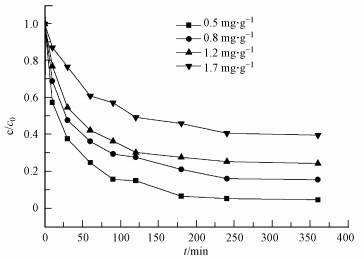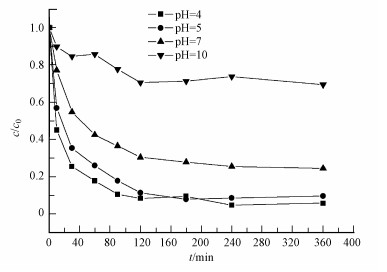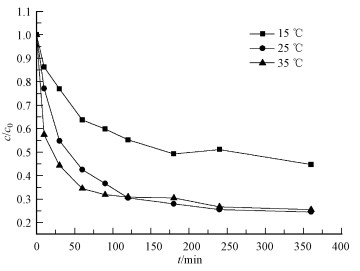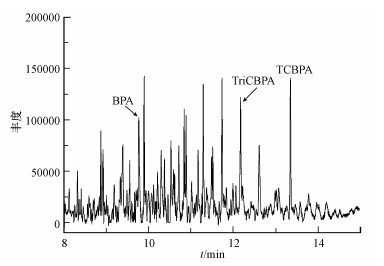 , 梁莉1,2,3, 李筱琴1,2,3
, 梁莉1,2,3, 李筱琴1,2,3
 , 杨琛1,2,3
, 杨琛1,2,31. 华南理工大学环境与能源学院, 广州 510006;
2. 工业聚集区污染控制与生态修复教育部重点实验室, 华南理工大学, 广州 510006;
3. 固体废物处理与资源化广东省环境保护重点实验室, 广州 510006;
4. 陡埠(武汉)科技服务有限公司, 武汉 430000
收稿日期: 2017-09-21; 修回日期: 2017-11-28; 录用日期: 2017-12-05
基金项目: 广东省自然科学基金项目(No.2016A030313507);国家自然科学基金面上项目(No.41773107)
作者简介: 付欣(1990—), 女, E-mail:fuxin0509@163.com
通讯作者(责任作者): 李筱琴(1974—),女,副教授,主要研究方向:重金属及有机污染土壤和水体的纳米修复技术;环境纳米材料的开发、表征、功能与调控机制研究;地下水和废水处理等. E-mail:xqli306@scut.edu.cn
摘要: 纳米零价铁及其双金属材料因比表面积大、反应活性高,已被大量应用于地下水中卤代有机污染物、无机盐和重金属的处理,而将纳米零价铁铜双金属(Cu/nZVI)应用于四氯双酚A(TCBPA)污染土壤的修复却鲜见报道.本文以Cu/nZVI为反应材料,探究了TCBPA起始浓度,Cu/nZVI投加量、pH、温度等因素对土壤中TCBPA降解率的影响.批实验结果表明:反应温度为25℃,经过360 min的反应后,0.30 g的Cu/nZVI对土壤中0.8 mg·g-1 TCBPA的降解率可达85%以上.Cu/nZVI对土壤中TCBPA的降解率随TCBPA初始浓度的增加而降低,随Cu/nZVI投加量的增加而升高,随土壤初始pH的增加而降低,Cu/nZVI对TCBPA的降解在常温条件下即可有效的进行.Cu/nZVI对TCBPA的降解遵循准一级反应动力学模型.GC-MS结果表明,Cu/nZVI降解TCBPA是一个逐步还原脱氯的过程.
关键词:Cu/nZVI四氯双酚A准一级反应动力学还原脱氯
Degradation of tetrachlorobisphenol A in soil by nanoscale zero-valent Copper/Iron bimetallic particles
FU Xin1,4
 , LIANG Li1,2,3, LI Xiaoqin1,2,3
, LIANG Li1,2,3, LI Xiaoqin1,2,3
 , YANG Chen1,2,3
, YANG Chen1,2,3 1. College of Environment and Energy, South China University of Technology, Guangzhou 510006;
2. The Key Laboratory of Pollution Control and Ecosystem Restoration in Industry Clusters of the Ministry of Education, South China University of Technology, Guangzhou 510006;
3. Guangdong Environmental Protection Key Laboratory of Solid Waste Treatment and Recycling, Guangzhou 510006;
4. Wuhan Benbu Technology Co., Ltd., Wuhan 430000
Received 21 September 2017; received in revised from 28 November 2017; accepted 5 December 2017
Supported by the Natural Science Foundation of Guangdong Province(No. 2016A030313507)and the National Natural Science Foundation of China(No. 41773107)
Biography: FU Xin(1990—), female, E-mail:fuxin0509@163.com
*Corresponding author: LI Xiaoqin, E-mail:xqli306@scut.edu.cn
Abstract: Due to its large special surface and high reactivity, nanoscale zero-valent iron and its bimetallic particles have been widely applied to remediate organic pollutants, inorganics, and heavy metals in groundwater. However, the application of Cu/nZVI for the remediation of Tetrachlorobisphenol A (TCBPA) contaminated soil have been rarely reported. In this paper, the influence of initial TCBPA concentration, Cu/nZVI dosage, initial solution pH and temperature for the degradation of TCBPA by 0.5 wt% Cu/nZVI were studied. Batch experiments showed that the reaction can be effectively carried out under ambient conditions. TCBPA (0.8 mg·g-1) could be degraded within 360 min by 0.30 g Cu/nZVI. The degradation rates decreased with the increase of initial TCBPA concentration and soil pH. Pseudo-first-order kinetics model could be used to fit the degradation of TCBPA by Cu/nZVI. GC-MS results elucidated that the degradation of TCBPA followed a step by step dechlorination process.
Key words: Cu/nZVITCBPApseudo-first-order kineticsreductive dechlorination
1 引言(Introduction)四氯双酚A(TCBPA)是一种应用广泛的阻燃剂,被广泛应用于建材、涂料、塑料制品、电子电路板中(林吉文等,1991;刘世城等,2014).TCBPA具有高脂溶性和化学稳定性,容易附着在各种环境介质如水、沉积物、悬浮颗粒物体中(Sellstr?m et al., 1995;Voordeckers et al., 2002).TCBPA是一种环境激素,其结构与甲状腺激素类似,并具有潜在致癌作用,长期接触会对人的大脑及骨骼发育产生有害影响(Meerts et al., 2000;Blanco et al., 2006;Olsen et al., 2003).因此,迫切需要开展TCBPA的降解研究.
目前,针对TCBPA的研究主要集中在其环境水平检测及其对动植物的毒性作用(Chu et al., 2005;Mascolo et al., 2010;Luigi et al., 2015;Huang et al., 2017),有关其污染修复的研究较少.少量几篇报道中(Eriksson et al., 2004;Horikoshi et al., 2008;Yuan et al., 2011;Nicolucci et al., 2011;Zhang et al., 2017),主要应用光催化和微生物技术降解TCBPA.Horikoshi等(2008)研究发现,以紫外线作为光照条件,用TiO2降解TCBPA,经过2 h的反应后,即可将其完全脱氯(pH=12时),继续反应3 h后TCBPA矿化CO2的比率约占45%~60%.Zhang等(2017)对电子垃圾场附近的河流沉积物进行研究,发现在产甲烷条件下,200 μmol·L-1的TCBPA在14 d后开始降解,160 d后降解率可以达到65%.光催化技术虽然降解速率快,效率高,但处理费用高,往往需要紫外光照射,不适用于实际工程;生物降解技术费用低,但处理周期长,效率低,缺乏合适的生物菌株.因此,仍有必要寻求更为快速有效降解TCBPA的方法.
在弱酸性条件下,利用Pd/Fe铁粉可将水体中的TCBPA,完全脱氯为BPA(Huang et al., 2013).而纳米零价铁及其双金属材料因比表面积大、反应活性高,对污染物的去除效率比铁粉或铁屑提高2个数量级(Li et al., 2008),已被大量应用于地下水中卤代有机污染物、无机盐和重金属的处理(Su et al., 2016;Zhu et al., 2016).将零价纳米铁双金属材料应用于TCBPA的降解,将可能进一步提高降解速率.我们前期研究表明,Ni/nZVI和Cu/nZVI双金属能快速将水体中的四溴双酚A脱溴(李瑛,2015;Li et al., 2016;Li et al., 2017),但目前仍未见到应用Cu/nZVI降解TCBPA的相关报道.
综上所述,本文利用Cu/nZVI双金属体系在常温常压下降解土壤中的TCBPA,研究TCBPA起始浓度,Cu/nZVI投加量、pH、温度等因素对土壤中TCBPA降解率的影响,探讨Cu/nZVI双金属体系降解土壤中TCBPA的机理,为TCBPA污染土壤的修复提供理论依据和技术支持.
2 材料与方法(Materials and methods)2.1 实验材料实验中所用六水合氯化铁(FeCl3·6H2O)、二水合氯化铜(CuCl2·2H2O)、硼氢化钠(NaBH4)、盐酸、丙酮均为分析纯;四氯双酚A、正己烷、甲醇为色谱纯;氮气纯度为99.999%.
2.2 模拟土壤的制备实验土壤采自广州大学城内某未受污染场地,土壤类型为红壤.取回的土壤经过风干、研磨、过筛(80目筛网)、混匀后装瓶.土壤的理化性质如下:pH为6.03;含水率为1.31%;用灼烧减量法(2015)测得土壤有机质含量为3.85%.XRD分析表明该土壤中主要矿物为高岭石.
用丙酮将一定量的TCBPA溶解后,倒入处理后的土壤并使溶液淹没土壤,用玻璃棒搅拌混合均匀.待丙酮溶剂完全挥发后,将配制好的TCBPA污染土壤过80目筛网并在阴暗条件下密封保存于玻璃瓶,老化2周备用.
2.3 Cu/nZVI的制备用蠕动泵以40 mL·min-1的滴速,将0.25 mol·L-1的NaBH4溶液加入0.045 mol·L-1的FeCl3溶液中,用电动搅拌器以600 r·min-1的转速不断搅拌反应液,制备nZVI(Li et al., 2016):
 | (1) |
在制备Cu/nZVI时,将10 g(干重)的nZVI,加入300 mL超纯水中.在通N2的条件下,用电动搅拌器以600 r·min-1的转速搅拌均匀后,加入5 mL 10 g·L-1的Cu储备液,搅拌15 min后,用处理nZVI的方法对其进行过滤,保存.
2.4 Cu/nZVI表征与分析采用Merlin场发射扫描电镜(德国ZEISS公司)对Cu/nZVI颗粒的形貌进行分析.采用ASAP 2020的比表面积分析仪(美国Micromeritics公司)对Cu/nZVI颗粒的比表面积大小进行分析.采用Axis Ulra DLD的X射线光电子能谱仪(英国Kratos公司)对Cu/nZVI颗粒的表面组成元素进行分析.
2.5 TCBPA的降解反应用100 mL蓝盖瓶作为反应器,称3 g(干重)TCBPA污染的土壤,根据固液比为1:10,向反应器中加入30 mL去离子水及一定质量的Cu/nZVI颗粒(干重),并立即将其置于摇床中(150 r·min-1)进行反应.设置不同的反应条件,包括TCBPA起始浓度(0.5、0.8、1.2、1.7 mg·g-1)、Cu/nZVI投加量(0.050、0.10、0.20、0.30 g)、pH(4、5、7、10)、温度(15、25、35 ℃).间隔时间取样,样品经2 mol·L-1 HCl淬灭后进行TCBPA浓度的测定及TCBPA降解中间产物的分析.在研究土壤pH影响时,用HCl和NaOH溶液调节土壤pH.如无特别说明,土壤中TCBPA的初始浓度为0.8 mg·g-1,调节土壤pH为7,Cu/nZVI的投加量为0.20 g,反应温度为25 ℃,Cu/nZVI与土壤中TCBPA反应时间为360 min.
样品中TCBPA浓度的检测及中间产物的分析分别采用高效液相色谱(HPLC)和气相色谱-质谱联用仪(GC-MS).TCBPA的HPLC分析条件为:采用250×4.60 mm的C18色谱柱;检测波长:238 nm;流动相(甲醇:水=90:10),流速1.0 mL·min-1.TCBPA降解后中间产物的GC-MS分析条件为:进样口、离子源、传输温度分别为280 ℃、230 ℃、280 ℃;升温程序:在75 ℃下保持1 min之后,以20 ℃·min-1的速率升温至310 ℃并在此温度下保持5 min;载气为He,流速1 mL·min-1,进样量1 μL.
3 结果与分析(Results and analysis)3.1 纳米零价铁体系表征结果3.1.1 SEM表征结果实验室新鲜制备的Cu/nZVI颗粒(图 1a)为较规则的球状(比表面积29.21 m2·g-1),粒径小于100 nm,由于磁力和表面张力的作用颗粒团聚在一起.与TCBPA反应后的颗粒(图 1b)因氧化从球状变成不规则片状结构.
图 1(Fig. 1)
 |
| 图 1 扫描电镜图(a.新鲜制备的Cu/nZVI;b.与TCBPA反应后的Cu/nZVI) Fig. 1SEM images of Cu/nZVI particles(a.before reaction; b.after reaction with TCBPA) |
3.1.2 XPS结果XPS全谱扫描图显示(图 2a),与TCBPA反应前后的Cu/nZVI均有较强的Fe、O、C元素的特征峰出现,可知Cu/nZVI的表面组成元素主要包括Fe、C、O,C的来源归因于材料在空气中暴露时与CO2的接触或者是合成材料时所用试剂自身含碳所致.同时与TCBPA反应前后的样品表面也可检测到微弱的Cu的特征峰,说明Cu元素成功地负载于nZVI表面.为了进一步研究,Fe在反应前后的价态变化,对Fe2p轨道进行窄谱分析,其结果如图 2b所示.可知反应前的Cu/nZVI在706.7 eV、710.2 eV、711.7 eV处出现特征峰,分别对应Fe0、Fe(Ⅱ)和Fe(Ⅲ),结合图 2a中颗粒表面检测到较强的O元素,表明Cu/nZVI表面的组成物质可能是三价铁或二价铁的氧化物及纳米零价铁颗粒.反应后的Cu/nZVI表面没有检测到Fe0特征峰的出现,说明与TCBPA反应后,Cu/nZVI表面的Fe0颗粒均被氧化.同时,对应的Fe(Ⅲ)和Fe(Ⅱ)的特征峰峰面积发生了变化(表 1):反应后检测不到Fe0,Fe(Ⅱ)和Fe(Ⅲ)的百分含量均有所升高,说明在反应过程中Cu/nZVI颗粒表面严重氧化,生成了三价铁及二价铁的氧化物.
图 2(Fig. 2)
 |
| 图 2 XPS谱图(a.Cu/nZVI的全谱图;b.Fe 2p3/2的窄谱图) Fig. 2XPS of (a) full scan and (b) narrow scan of Fe 2p3/2 of the Cu/nZVI particles before and after the reaction with TCBPA |
表 1(Table 1)
| 表 1 反应前及反应后Cu/nZVI表面Fe0、Fe(Ⅱ)、Fe(Ⅲ)的百分含量 Table 1 The ratio of Fe0, Fe(Ⅱ), and Fe(Ⅲ) at the surface of Cu/nZVI before and after reaction with TCBPA | |||||||||||||||
表 1 反应前及反应后Cu/nZVI表面Fe0、Fe(Ⅱ)、Fe(Ⅲ)的百分含量 Table 1 The ratio of Fe0, Fe(Ⅱ), and Fe(Ⅲ) at the surface of Cu/nZVI before and after reaction with TCBPA
| |||||||||||||||
3.2 影响Cu/nZVI降解TCBPA的因素3.2.1 TCBPA初始浓度对土壤中TCBPA降解的影响本实验研究了Cu/nZVI投加量为0.20 g,反应温度为25 ℃,TCBPA浓度分别为0.5、0.8、1.2、1.7 mg·g-1时TCBPA的降解率随时间的变化情况,结果如图 3所示. TCBPA初始浓度越高时,其降解率越低,对于不同浓度的反应在360 min后均趋于平衡.当TCBPA浓度在0.8 mg·g-1以下时,反应至平衡时TCBPA降解率都在80%以上,而浓度为1.2 mg·g-1时,相同时间内的降解率为75%左右.由于Cu/nZVI的活性位点和表面积有限,因此降解率将随着TCBPA浓度增加而下降.
图 3(Fig. 3)
 |
| 图 3 TCBPA初始浓度对反应的影响 Fig. 3The effect of initial TCBPA concentration on the reaction |
3.2.2 Cu/nZVI投加量对土壤中TCBPA降解的影响为了研究Cu/nZVI投加量对土壤TCBPA降解的影响,在TCBPA初始浓度为0.8 mg·g-1,反应温度为25 ℃的条件下,设置Cu/nZVI投加量分别为0.050 g、0.10 g、0.20 g和0.30 g,土壤中TCBPA的降解率随时间变化的关系如图 4所示.TCBPA的降解率随着Cu/nZVI投加量的增加而增大.在前120 min,TCBPA的降解较快,降解率随投加量不同可达到30%~80%.反应360 min后,投加量为0.30 g时,TCBPA的降解率可达85%以上.
图 4(Fig. 4)
 |
| 图 4 Cu/nZVI投加量对TCBPA降解的影响 Fig. 4The effect of initial Cu/nZVI dosage on the removal of TCBPA |
3.2.3 pH对土壤中TCBPA降解的影响为了研究pH对土壤TCBPA降解的影响,设置pH为4、5、7、10.实验是在土壤TCBPA初始浓度为0.8 mg·g-1,反应温度为25 ℃,Cu/nZVI投加量为0.20 g的条件下进行的.TCBPA的降解率随时间的变化结果如图 5所示.反应进行至360 min,TCBPA的降解率分别达到94.1%、90.3%、75.4%、30.5%.可见pH对反应的影响较大,这与用Ni/nZVI降解TBBPA的结果一致(Li et al., 2016).以往的研究(Johnson et al., 1996;Arnold et al., 2000;Fang et al., 2008)表明,零价铁降解氯代有机物的反应遵循准一级动力学方程:
 | (2) |
 |
| 图 5 pH对土壤中TCBPA降解的影响 Fig. 5The effect of initial pH on the removal of TCBPA |
式中,c为TCBPA在t(min)时刻的浓度(mg·g-1);c0为TCBPA的起始浓度(mg·g-1);kobs为表观比速率(min-1).
pH值分别为4、5、7、10时的准一级动力学模型如图 6所示,kobs随着pH的降低而增加,pH从4增加到10时,kobs则从1.86×10-2 min-1降低到0.18×10-2 min-1.在低pH条件下,H+会促进Cu/nZVI的腐蚀,从而产生大量H2,使得TCBPA的降解加快.当pH较高时,材料表面会钝化,致使TCBPA的降解变弱.
图 6(Fig. 6)
 |
| 图 6 kobs随pH值的变化 Fig. 6The correlation between pH and kobs |
3.2.4 温度对土壤中TCBPA降解的影响为了研究温度对TCBPA降解的影响,设置反应温度为15 ℃、25 ℃、35 ℃.在实验过程中Cu/nZVI投加量为0.20 g,TCBPA浓度为0.8 mg·g-1,TCBPA降解率随时间的变化关系见图 7.在3种反应温度下,TCPBA的降解效率在100 min后均趋于稳定,360 min后降解率分别为55.27%,75.49%,75.44%.可见温度从15 ℃增加到25 ℃时,TCBPA的降解效率将提高20.22%,继续增加温度对TCBPA的降解效率影响不大.由此可见,Cu/nZVI对TCBPA的降解在常温条件下即可有效的进行.
图 7(Fig. 7)
 |
| 图 7 温度对土壤中TCBPA降解的影响 Fig. 7The effect of temperature on the removal of TCBPA |
根据阿伦尼乌斯公式可求出Cu/nZVI与TCBPA反应的表观活化能(徐新华等,2004).阿伦尼乌斯公式如下:
 | (3) |
3.3 Cu/nZVI降解土壤中TCBPA的机理分析利用GC-MS对TCBPA的降解产物进行定性分析,本实验TCBPA的浓度为0.8 mg·g-1,Cu/nZVI的投加量为0.20 g,反应温度为25 ℃,TCBPA反应120 min后的产物分析图见图 8.从图 8可知,TCBPA的降解产物有三氯双酚A(TriCBPA)和双酚A(BPA),二氯双酚A(DCBPA)和一氯双酚A(MCBPA)在降解产物中不存在.可知TCBPA的降解是通过还原脱氯进行的,并且其降解是一个逐步脱氯的过程,见图 9.
图 8(Fig. 8)
 |
| 图 8 Cu/nZVI与TCBPA反应120 min时的质谱图 Fig. 8MS spectrum of intermediates of TCBPA after reaction with Cu/nZVI in 120 min |
图 9(Fig. 9)
 |
| 图 9 TCBPA的还原降解途径 Fig. 9The reductive degradation pathways of TCBPA |
在Cu/nZVI双金属体系中,Cu是一种良好的催化剂,会加速纳米零价铁的腐蚀,产生更多的H2,从而使得TCBPA的还原脱氯速率加快(Noubactep,2009).Cu负载在nZVI表面,Cu/nZVI促进TCBPA还原脱氯主要表现在以下几个方面:
(1) Cu的负载促进TCBPA脱氯.Cu会与TCBPA中的-Cl结合,从而加速TCBPA的脱氯.
(2) Cu/nZVI的原电池作用.当Cu负载到nZVI表面时,会与铁形成原电池(Li et al., 2016),从而促进电子从铁转移到铜,最后使得-Cl带电从TCBPA中脱离,以氯离子形在.
(3) 氢原子的脱氯作用.纳米零价铁在腐蚀过程中,会产生大量H2包裹在Cu的表面,并逐渐解离成氢原子(Ghauch et al., 2016),在Cu的催化作用下,氢原子的脱氯反应变得更加剧烈,使得TCBPA脱氯并产生双酚A.
4 结论(Conclusions)1) 实验室制备的新鲜Cu/nZVI为较规则的球形,主要以Fe0形式存在,还有少量Fe(Ⅱ)和Fe(Ⅲ)的氧化物.与TCBPA反应后颗粒变成不规则片状结构,其表面检测不出Fe0.
2) 批实验结果表明,Cu/nZVI可快速有效降解土壤中的TCBPA.常温下,0.30 g的Cu/nZVI对中性土壤中0.8 mg·g-1 TCBPA的降解率在6 h内可达85%以上.Cu/nZVI对土壤中TCBPA的降解率随TCBPA初始浓度的增加而降低,随Cu/nZVI投加量的增加而升高.弱酸性pH条件下有利于TCBPA的降解,碱性条件下则降解率迅速降低.当土壤中初始浓度为0.8 mg·g-1时,TCBPA的最佳降解条件为:25 ℃,土壤初始pH为4,Cu/nZVI投加量0.2 g,土壤中TCBPA的降解率在360 min内可达94.10%.
3) Cu/nZVI通过逐步还原脱氯降解TCBPA,终产物为BPA,反应生成的中间产物主要是TriCBPA.
参考文献
| Arnold W A, Roberts A L. 2000. Pathways and kinetics of chlorinated ethylene and chlorinated acetylene reaction with Fe0 particles[J]. Environmental Science and Technology, 34(9): 1794–1805.DOI:10.1021/es990884q |
| Blanco E, Casais M C, Mejuto M C, et al. 2006. Approaches for the simultaneous extraction of tetrabromobisphenol A, tetrachlorobisphenol A, and related phenolic compounds from sewage sludge and sediment samples based on matrix solid-phase dispersion[J]. Analytical Chemistry, 78(8): 2772–2778.DOI:10.1021/ac0522512 |
| Chu S G, Haffner G D, Letcher R J. 2005. Simultaneous determination of tetrabromobisphenol A, tetrachlorobisphenol A, bisphenol A and other halogenated analogues in sediment and sludge by high performance liquid chromatography-electrospray tandem mass spectrometry[J]. Journal of Chromatography A, 1097: 25–32.DOI:10.1016/j.chroma.2005.08.007 |
| Cuypers C, Grotenhuis T, Nierop K G J, et al. 2002. Amorphous and condensed organic matter domains:the effect of persulfate oxidation on the composition of soil/sediment organic matter[J]. Chemosphere, 48(9): 919–931.DOI:10.1016/S0045-6535(02)00123-6 |
| Eriksson J, Rahm S, Green N, et al. 2004. Photochemical transformations of tetrabromobisphenol A and related phenols in water[J]. Chemosphere, 54: 117–126.DOI:10.1016/S0045-6535(03)00704-5 |
| Fang Y, Al-Abed S R. 2008. Dechlorination kinetics of monochlorobiphenyls by Fe/Pd:Effects of solvent, temperature, and PCB concentration[J]. Applied Catalysis B:Environmental, 78(3): 371–380. |
| Ghauch A, Assi H A, Baydoun H, et al. 2011. Fe0-based trimetallic systems for the removal of aqueous diclofenac:mechanism and kinetics[J]. Chemical Engineering Journal, 172: 1033–1044.DOI:10.1016/j.cej.2011.07.020 |
| Horikoshi S, Miura T, Kajitani M, et al. 2008. Photodegradation of tetrahalobisphenol-A (X=Cl, Br) flame retardants and delineation of factors affecting the process[J]. Applied Catalysis B:Environmental, 84(3/4): 797–802. |
| Huang Q, Liu W, Peng P A, et al. 2013. Reductive dechlorination of tetrachlorobisphenol A by Pd/Fe bimetallic catalysts[J]. Journal of Hazardous Materials, 262c(22): 634–641. |
| Huang Q S, Chen Y J, Lin L F, et al. 2017. Different effects of bisphenol A and its halogenated derivatives on the reproduction and development of oryzias melastigma under environmentally relevant doses[J]. Science of the Total Environment, 595: 752–758.DOI:10.1016/j.scitotenv.2017.03.263 |
| Johnson T L, Scherer M M, Tratnyek P G. 1996. Kinetics of halogenated organic compound degradation by iron metal[J]. Environmental Science and Technology, 30(8): 2634–2640.DOI:10.1021/es9600901 |
| Li X Q, Cao J S, Zhang W X. 2008. Stoichiometry of Cr (Ⅵ) immobilization using nanoscale zerovalent iron (nZVI):A study with high-resolution X-Ray photoelectron spectroscopy (HR-XPS)[J]. Industrial & Engineering Chemistry Research, 47: 2131–2139. |
| 李瑛. 2015. 纳米零价铁双金属体系降解四溴双酚A的研究[D]. 广州: 华南理工大学. 1-117http://cdmd.cnki.com.cn/Article/CDMD-10561-1015988175.htm |
| 李瑛, 肖阳, 李筱琴, 等. 2015. 纳米零价铁及其双金属体系对菲的降解研究[J]. 环境科学学报, 2015, 35(2): 499–507. |
| Li Y, Li X Q, Xiao Y, et al. 2016. Catalytic debromination of tetrabromobisphenol A by Ni/nZVI bimetallic particles[J]. Chemical Engineering Journal, 284: 1242–1250.DOI:10.1016/j.cej.2015.09.079 |
| Li Y, Li X Q, Han D H, et al. 2017. New insights into the role of Ni loading on the surface structure and the reactivity of nZVI toward tetrabromo-and tetrachlorobisphenol A[J]. Chemical Engineering Journal, 311: 173–182.DOI:10.1016/j.cej.2016.11.084 |
| 林吉文. 1991. 四氯双酚A环氧树脂合成的研究[J]. 广东化工, 1991(02): 5–7. |
| 刘世诚, 李玲玲, 任源, 等. 2014. 河道底泥中四氯双酚A的厌氧降解及硫酸盐还原菌对其降解效率的影响[J]. 环境化学, 2014, 33(06): 915–922. |
| Luigi V, Giuseppe M, Claudio R. 2015. Emerging and priority contaminants with endocrine active potentials in sediments and fish from the River Po (Italy)[J]. Environmental Science and Pollution Research International, 22: 14050–14066.DOI:10.1007/s11356-015-4388-8 |
| Mascolo G, Locaputo V, Mininni G. 2010. New perspective on the determination of flame retardants in sewage sludge by using ultrahigh pressure liquid chromatography-tandem mass spectrometry with different ion sources[J]. Journal of Chromatography A, 1217: 4601–4611.DOI:10.1016/j.chroma.2010.05.003 |
| Meerts I A, Zanden J J van, Luijks E A, et al. 2000. Potent competitive interactions of some brominated flame retardants and related compounds with human transthyretin in vitro[J]. Toxicological Sciences, 56(1): 95–104.DOI:10.1093/toxsci/56.1.95 |
| Nicolucci C, Rossi S, Menale C, et al. 2011. Biodegradation of bisphenols with immobilized laccase or tyrosinase on polyacrylonitrile beads[J]. Biodegradation, 22: 673–683.DOI:10.1007/s10532-010-9440-2 |
| Noubactep C. 2009. On the operating mode of bimetallic systems for environmental remediation[J]. Journal of Hazardous Materials, 164: 394–395.DOI:10.1016/j.jhazmat.2008.08.004 |
| Olsen C M, Meussen-Elholm E T M, Samuelsen M, et al. 2003. Effects of the environmental oestrogens bisphenol A, tetrachlorobisphenol A, tetrabromobisphenol A, 4-hydroxybiphenyl and 4, 4'-dihydroxybiphenyl on oestrogen receptor binding, cell proliferation and regulation of oestrogen sensitive proteins in the human breast cancer cell line MCF-7[J]. Pharmacology & Toxicology, 92(4): 180–188. |
| Sellstr?m U, Bo J. 1995. Analysis of tetrabromobisphenol A in a product and environmental samples[J]. Chemosphere, 31(4): 3085–3092.DOI:10.1016/0045-6535(95)00167-7 |
| Su H J, Fang Z Q, Tsang P E, et al. 2016. Remediation of hexavalent chromium contaminated soil by biochar-supported zero-valent iron nanoparticles[J]. Journal of Hazardous Materials, 318: 533–540.DOI:10.1016/j.jhazmat.2016.07.039 |
| Voordeckers J W, Fennell D E, Jones K, et al. 2002. Anaerobic biotransformation of tetrabromobisphenol A, tetrachlorobisphenol A, and bisphenol A in estuarine sediments[J]. Environmental Science and Technology, 36(4): 696–701.DOI:10.1021/es011081h |
| 徐新华, 金剑, 卫建军, 等. 2004. 纳米Pd/Fe双金属对2, 4-二氯酚的脱氯机理及动力学[J]. 环境科学学报, 2004, 24(04): 561–567.DOI:10.3321/j.issn:0253-2468.2004.04.001 |
| Yuan S Y, Chen S J, Chang B V. 2011. Anaerobic degradation of tetrachlorobisphenol-A in river sediment[J]. International Biodeterioration & Biodegradation, 65(1): 185–190. |
| Zhang J, Liu S C, Li L L, et al. 2017. Anaerobic dechlorination of tetrachlorobisphenol A in river sediment and associated changes in bacterial communities[J]. Water, Air, & Soil Pollution, 228(2): 78–92. |
| 中华人民共和国环境保护部. 2015. HJ 761-2015固体废物有机质的测定灼烧减量法[S]. 北京: 中国环境科学出版社 |
| Zhu F, Li L W, Ma S Y, et al. 2016. Effect factors, kinetics and thermodynamics of remediation in the chromium contaminated soils by nanoscale zero valent Fe/Cu bimetallic particles[J]. Chemical Engineering Journal, 302: 663–669.DOI:10.1016/j.cej.2016.05.072 |
